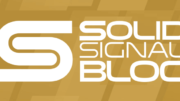Note: Please download the PDF to see the graphics which originally accompanied this article.
DIRECTV’s HR34 is the top of the heap. There’s no other consumer DVR that lets you record any 5 HD channels any time you want. Dish’s Hopper lets you record 6, but 4 of them must be network (ABC/NBC/CBS/Fox) prime time channels. AT&T gives you 4 SD, but only 3 HD with their highest service. For the ultimate in flexibility you need the HR34.
Yet, when the HR34 launched this past fall, it came with the older, blue menus that DIRECTV has been using since about 2007. The older DIRECTV DVRs were treated to a new, fresh menu that rendered in high-def but the flagship didn’t get that update… until now.
Solid Signal’s team were treated to an advance look at the HR34 with HD Menus.
A bit of disclaimer here: It’s really difficult to capture the full resolution menus. These are upsampled screen captures and don’t reflect the full experience.
The HR34 is a size larger than the HR24. If you look at the picture to the left, you’ll see the HR34 at the bottom really sticks out quite a bit from the HR24. It’s taller, wider, and deeper. It’s still small enough to fit in the average equipment rack, so it shouldn’t be a problem. The HR34 is also louder than the HR24 when the fan is running, but like all DIRECTV receivers it’s got power management features so that fan does not run all the time It’s mostly limited to bootup and occasionally when the DVR is doing a lot of work.
DIRECTV has done a lot of work in previous years aimed toward keeping their DVRs cool and quiet and I think you’ll find that the HR34 is consistently quieter than an HR21.
Looking at the back panel of the HR34 it’s sparser than previous DVRs. In the past you had multiple sets of outputs and some receivers had optical outs. DIRECTV is moving to a more HDMI-centric approach now that HDMI-equipped AV receivers are the norm, so the other outputs are less important.
There is only one satellite input because the HR34 is SWM-only. There is no way to use an HR34 with a legacy system. This is done because the RVU clients cannot function on a legacy system. While RVU is only a small part of what the HR34 does today, it’s going to become increasingly important throughout 2012 as the number of RVU-equipped TVs increases and DIRECTV comes out with its own RVU adapter to let any TV get a DVR experience without a DVR in that room.
For the most part, the new menus look exactly like the ones on the HR24 and older DVRs. A clear giveaway that this is the HR34 is the PIP menu on the right side. The info bar itself has the same function as the previous info bar so if you’ve set remote macros to function with the old info bar you will not have program them again here.
The text is a lot easier to read in 720p, 1080i, and 1080p resolutions than it was previously. These screen grabs don’t show it but it’s a lot sharper than it was. Native text renders in 480i and 480p are ok, but obviously limited by screen resolution.
There were some complaints when the HD menus came out for previous receivers, specifically that the dark area at the bottom was much larger than it really needed to be. This was addressed in the latest release for HR24 and older receivers and although the big dark area is still there on the HR34, it’s pretty likely that DIRECTV will fix that in a later release. I for one never had a problem with the dark area at the bottom but apparently some people said that it made it difficult to see sports scores crawling by.
The overall menu structure should be familiar to anyone who has used the HD menus on other DIRECTV receivers. The main menu is called “My DIRECTV” and features two rows of informative posters. The top row tells you what’s on now that may be of interest to you. The bottom row tells you about upcoming programs that you might like, based on your viewing preferences. This menu adapts to you, so it’s not going to be particularly accurate when it first loads but over time it gets a lot better.
When there is no graphic available for a particular program, a generic blue background is used instead.
DIRECTV’s Smart Search is as smart as ever. You can use the arrows to get to letters you want, or you can tap like using a cell phone for texting (press “2” once for “A”, twice for “B”, etc.) The HD menus make the suggested searches a lot better because it’s easier to see the graphics to the left of the text.
Just as before, once you start searching, you get suggestions right away, making the whole search process faster.
The HD guide doesn’t give you more information, which was a bit of a disappointment, but given that DIRECTV has to make this guide legible for TVs from 13″ to 80″, it does a pretty good job. The text is a lot more legible. When these menus first came out for other receivers, some people complained that they were too dark, but using the guide for basic calibration can really help this. With this screen, adjust the brightness until it’s possible to tell the difference between the solid black areas at the top and the dark grey areas behind the guide. Then, adjust the contrast so that all the text is legible but the gray backgrounds don’t disappear.
Our team produced a quick video to give you the high points of the HR34. Click below to play.
This review is available in PDF format! Click here to view or download!





